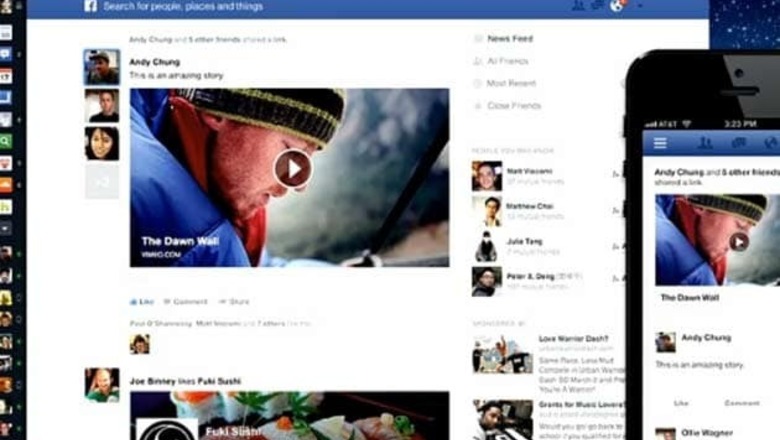
views
Menlo Park: Facebook introduced the biggest change in years to its popular newsfeed on Thursday, with a new look and focus on photos that is expected to make the social network more ad-friendly and may entice users to spend more time on the website.
The changes to the newsfeed, whose look and feel had remained largely unchanged since Facebook's inception, include a division into several sections, with separate areas for photographs and music.
The newsfeed is the ever-changing stream of photos, videos and comments uploaded from friends, and is the first page most users see upon logging in.
Facebook Chief Executive Mark Zuckerberg said the makeover was part of an effort to position the social network as a "personalised newspaper," complete with different sections for users to explore.
It comes with a revamped interface that gives more prominence to visual media, such as photos and videos.
The makeover comes roughly a month after Facebook introduced a new social search feature it dubbed "graph search" that makes it easier for the social network's more than 1 billion users to discover more content on the social network.
The much-needed changes unveiled on Thursday, which standardise the network's look across different types of desktop and mobile devices, bring Facebook up-to-date as Google+, the much younger social network started by Google, begins to incorporate more video and images.
"This is just going to provide more opportunity for people to click around and stick around," said Brian Blau, an analyst with industry research firm Gartner, about the revamped newsfeed.
"The newsfeed was kind of outdated. This sort of brings it up to maybe what's comparable to...their competition, and partner sites that are focusing on media and richness."
Facebook's newsfeed is one of three "pillars" of the service, along with search and user profiles.
The updated newsfeed provides more space for the photos and videos that users share on the network, and provides a more consistent look and feel between the version for PCs and for mobile devices such as smartphones and tablets. The changes will begin rolling out in limited fashion from Thursday, Facebook said.
Facebook executives say the updates will help keep organized the increasing jumble of content available on the social network as its user base grows.
The last major update to the feature occurred in September 2011. Since then, the company has incorporated ads directly into the feed and has shifted its focus to creating "mobile-first experiences," because more people now access the social network from smartphones than from desktop computers.
Facebook versus Google
Marketers will be able to fashion more compelling ads thanks to the increased real estate for photos, said Hussein Fazal, the chief executive of AdParlor, a firm that helps companies advertise on Facebook. "Larger images will result in higher click through-rates, a higher level of engagement and better performance," Fazal wrote in an email.
Still, analysts say the company needs to tread carefully to avoid inundating users' various feeds with advertising, as Facebook tries to sustain a rapid pace of growth that helped it debut on public markets at the highest-ever valuation for a technology company.
The world's largest social network is moving to regain Wall Street's confidence after its botched IPO last year, addressing concerns about its long-term prospects - many of which center on an industry-wide shift toward the use of mobile devices.
Facebook shares, which are still more than a quarter off their IPO price of $38, closed up 4 per cent at $28.57 on Thursday on the Nasdaq.
Facebook and Google, which both got their start on desktop computers, are now managing a transition of their products onto smartphones and tablets, which typically yield less revenue than on PCs.
The two Internet mainstays are also waging a war for revenue in mobile advertising - a market that is still small compared with the traditional desktop but that is growing exponentially.
In terms of overall mobile advertising, Google commanded a 53.5 percent share in 2012, aided by its dominance in search-based ads. Facebook had just 8.4 percent, a distant runner-up, according to estimates from research house eMarketer.
But in terms of mobile display ad sales, Facebook narrowly edges out its rival with 18.4 percent of the market versus Google's 17 percent, the research outfit estimated.
Pressure on the system
The makeover is partly prompted by complaints about increasing clutter on Facebook's network.
As Facebook has grown to more than 1 billion users, the amount of content that users and companies post to the website has surged. Facebook users only see a small portion of that content, culled by Facebook's proprietary algorithm.
In recent months, some companies and users, including entrepreneur Mark Cuban, have grumbled that their content was not getting enough exposure in the newsfeed, because Facebook gives paid ads priority in the newsfeed.
Facebook's vice president of product, Chris Cox, acknowledged that there was "more pressure on the system" to feature the various content, as Facebook has grown in size.
The additional newsfeeds provide more opportunities for content to appear in front of users. A photos-only feed displays pictures shared by a user's connections on Facebook as well as on Facebook-owned Instagram and other photo apps that are integrated with the social network.
A revamped version of an existing but little-used Music feed aggregates the songs that a user's friends are listening to, and includes posts from bands and performers in which a user has expressed an interest.
Facebook also introduced a "Friends Only" feed that displays every message shared by a user's friends in chronological order -- rather than chosen by an algorithm - as well as a "Following" feed that gathers posts from news publishers, celebrities, sports teams and other groups or businesses that a user subscribes to.
"The basic idea is sometimes you want five minutes and you want to see the top stuff, sometimes you want to spend an hour and go through a lot of different stuff," Cox said in an interview after the event.
The additional feeds could also provide Facebook with more space to offer ads on its newsfeed, though a spokeswoman said the additional news feeds would not initially feature ads.



















Comments
0 comment